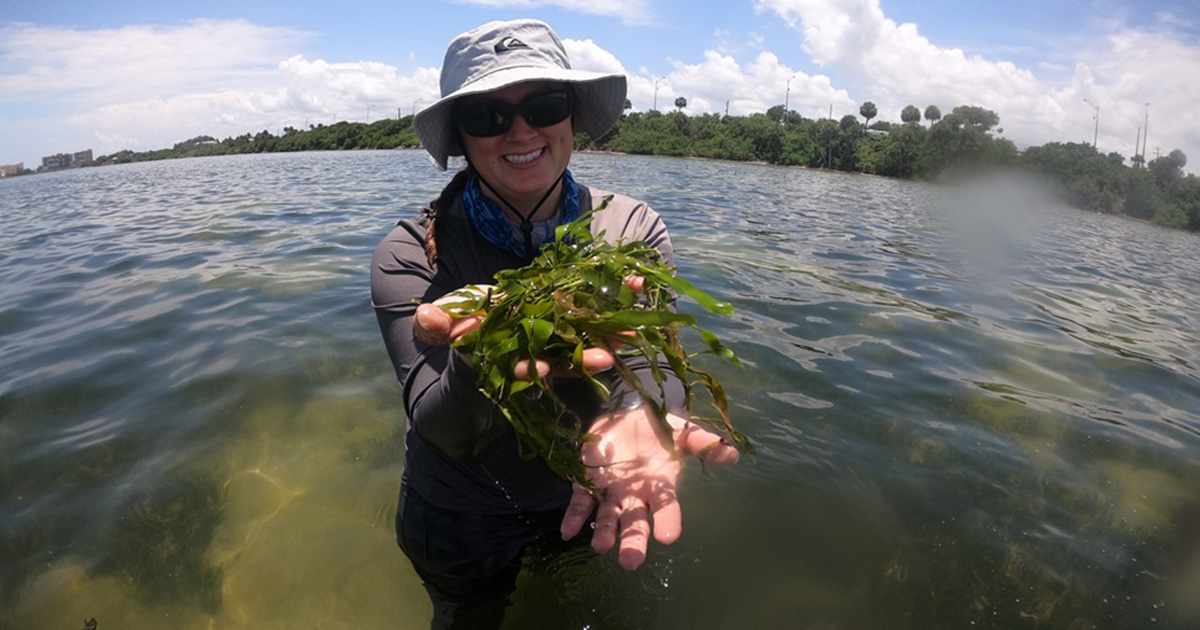The Indian River Lagoon was considered one of the last “unpolluted coastal lagoons” in Florida in the 1970s. Fast forward to today and most of the 156-mile lagoon is now considered impaired because of external sources of nutrients including human waste, fertilizers, stormwater runoff, agriculture, rainfall and sub-marine groundwater discharge.
As a result, the lagoon—especially the Northern Indian River Lagoon and Banana River—has experienced various harmful algal blooms, catastrophic seagrass losses, and is the epicenter of Florida manatee starvation and deaths. Seagrasses are keystone species within estuaries and provide many important ecosystem services, including the facilitation of nutrient cycling, essential habitat, sediment stabilization and carbon sequestration.
To better understand factors related to seagrass losses in the Indian River Lagoon, researchers from Florida Atlantic University's Harbor Branch Oceanographic Institute conducted a unique, long-term monitoring study that examined the cover of seagrass and macroalgae in the lagoon from 2011 to 2020 compared to factors such as nutrients and the chemical composition of macroalgae. Data from the study provide important insight into the drivers of change in the lagoon, which are necessary for managers seeking to mitigate habitat losses, facilitate recovery and improve resilience.
Results of the study, published in the journal Ecological Indicators, reveal that since the 2011 blue green “super bloom,” benthic cover in large parts of the Northern Indian River Lagoon and Banana River has significantly changed from primarily the seagrass Halodule wrightii until 2015, to primarily the green macroalga Caulerpa prolifera after 2018. While native to the Indian River Lagoon, C. prolifera acts as an invasive species that can move into new spaces and dominate due to its competitive ability in impaired habitats. Though with the low seagrass cover, competition was likely not a factor in this replacement.
“The change in primary benthic cover from seagrass to green macroalgae has the potential to cause cascading ecological effects, both directly and indirectly,” said Brian Lapointe, Ph.D., senior author, and a research professor at FAU Harbor Branch. “Vegetation on the bottom of a body of water responds to multiple simultaneous pressures, including variations in light availability, nutrient availability, salinity, and herbivore pressure, which is why we used a multivariate approach to determine variables that are important to change.”
For the study, researchers compared two long-term datasets from FAU Harbor Branch and St. Johns River Water Management District that included benthic plant cover and many other factors, including water temperature, salinity, pH, dissolved oxygen, nutrient concentrations and macroalgal carbon, nitrogen, and phosphorus content, and stable isotopes at six locations in the Northern Indian River Lagoon and Banana River.
The primary factor that was relatable to changes in the benthic cover by year was the carbon-to- phosphorus ratio of macroalgae. This suggests that the change was associated with increased phosphorus availability, which may have been the result of heavy rainfall, increased sediment flux, and/or more biologically available nutrients due to seagrass losses. Salinity also was frequently identified as an important variable related to changes in the benthic cover percent composition, therefore inflow patterns of stormwater and other freshwater sources are likely influential.
The increase in C. prolifera was associated with four years (2016 to 2019) of high ammonium concentrations and macroalgal nitrogen isotope values, linking the blooms with the influence of human waste. The influence of human waste in the study area was further supported by the presence of sucralose, an artificial sweetener, in the study area in 2022 to 2023.
Ammonium is the predominant form of nitrogen in septic tank effluent that flows into groundwaters and ultimately the lagoon. The apparent relationship between increasing C. prolifera percent cover and ammonium suggests that improving wastewater infrastructure and reducing the number of homes using septic systems could help to reduce these blooms, which would favor seagrass recovery by decreasing competition with other primary producers.
“Loss of seagrasses in urbanized estuaries is common, as they are highly susceptible to watershed nutrient and sediment inputs, making seagrasses effective biological sentinels,” said Rachel Brewton, Ph.D., first author and a research scientist at FAU Harbor Branch. “Reducing stormwater runoff and inputs of human waste and the associated nutrient load will help promote the recovery of seagrasses in the Indian River Lagoon. Importantly, our study findings have implications for urbanized estuaries experiencing seagrass losses globally.”
Notably, the significant decreases in seagrasses observed since 2011, followed by subsequent increases in C. prolifera in many segments of the Northern Indian River Lagoon and Banana River, occurred when a change in manatee diet was observed from primarily seagrass to primarily macroalgae.
“In addition to starvation from the catastrophic loss of seagrasses, the unusual mortality of Florida manatees also has been attributed to bacterial toxins in a prior study by other researchers, initiated by the diet switch from seagrasses to macroalgae that resulted in a lethal clostridial infection,” said Lapointe. “The green macroalgae Caulerpa produce a toxic bioactive chemical compound that is transformed into more toxic and deterrent oxytoxins and are not a suitable replacement for seagrass in manatee diets. The changing benthic cover in the lagoon has profound effects on the survival of these important herbivores.”
Currently, there is no management of C. prolifera in the Indian River Lagoon and discussions are ongoing regarding whether it should be protected as an essential habitat or harvested, along with drift macroalgae, to remove nutrients from the systems.
“Both bottom-up, nutrient-loading, and top down consumer influences interact to influence seagrass-macroalgae interactions, therefore managers must strive to consider both as they plan for seagrass recovery efforts,” said Brewton.
This research was funded by the Harbor Branch Oceanographic Institute Foundation through the Florida Center for Coastal and Human Health and the Indian River Lagoon Graduate Research Fellowship (2019 to 2022).



